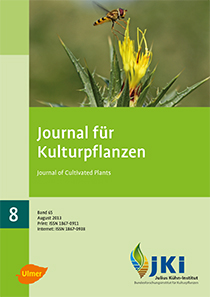New finds of the click beetle <em>Agriotes sordidus</em> (Illiger, 1807) and an overview on its current distribution in Germany
DOI:
https://doi.org/10.5073/JfK.2013.08.02Keywords:
Wireworms, click beetle monitoring, Agriotes sordidus, distribution, pheromone trapsAbstract
Some of the most damaging wireworms in middle European arable land belong to the genus Agriotes. One of the five species of this genus which are of economic importance in Germany, is a newcomer. The species in question, Agriotes sordidus, is essentially western Mediterranean in its distribution, however, showing a range extension to the north in Western Europe in recent decades. In Germany A. sordidus now shows a continuous distribution along the Upper Rhine valley and its tributaries (e.g. Neckar, Nahe, Main), as was shown recently. The species is also recorded in the countrywide click beetle monitoring with additional finds at the southern edge of the Cologne lowland (first find in North Rhine-Westphalia), the region of Zusmarshausen in western Bavaria, and most surprising, two locations close to the North Sea coast in Lower Saxony and Schleswig-Holstein (first find in this federal state). The latter two sites and also the Bavarian site near Zusmarshausen are far from the area of continuous distribution in southwestern Germany. As northern German specimens differed visually from the southern German finds the morphological determination was verified by PCR. Therefore A. sordidus is already more widespread than previously thought, but still missing in most regions. No records exist from eastern Germany yet. However, the habitat preferences and the damage potential of this species are still not fully understood. The spread of A. sordidus should be monitored further.
Published
Issue
Section
License
The content of the journal is licensed under the Creative Commons Attribution 4.0 License. Any user is free to share and adapt (remix, transform, build upon) the content as long as the original publication is attributed (authors, title, year, journal, issue, pages).
The copyright of the published work remains with the authors. The authors grant the Journal of Cultivated Plants, the Julius Kühn-Institut and the OpenAgrar repository the non-exclusive right to distribute and exploit the work.







